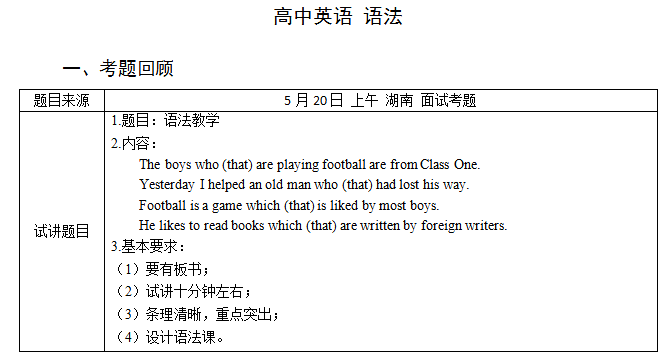作者:陕师大教师资格证培训中心
添加时间: 2018-11-18 10:46:36内容摘要:2018年上半年高中英语教师资格面试试题(精选)第三批。
二、考题解析
【教案】
Teaching Aims
Knowledge aims
Students will know the form and usage of attributive clause lead by who, which and that.
Ability aim
Students can enhance their ability of understanding the knowledge which is more professional and difficult.
Emotional aim
After this lesson, students will improve their confidence of learning English.
Teaching Key &Difficult Points
Key point: attributive clause;
Difficult point: How to understand and use the attributive clause.
Teaching procedures
Step 1: Warming up
Show some adverbial clause on the screen, let students look at this sentences carefully and find the similarities among them. After observation, do a conclusion together :“They all describe the verbs like adverbs.”
I will call you as soon as I arrive in Beijing.
Where you work, you should work hard.
My friends like me because I’m honesty.
Step 2: Presentation
Show these four sentences on the blackboard.
1.Students try to translate these sentences. Invite some students to share their answers. The answers are as follows:
正在踢足球的男孩是一班的。
昨天我帮助了一位迷路的老人。
足球是大多数男孩所喜欢的运动。
他喜欢外国作家写的书。
2. Let them observe these two sentence, find the common between them. Tell them the function and meaning of attributive clause.
The rules are shown in the following part:
① The function of attributive clause is to modify the previous word (antecedent).
② When the antecedent is human being, we should use the relative pronoun: who.
③ When the antecedent is something, we should use the relative pronoun: which.
④ No matter the the antecedent is something or someone, the relative pronoun: that can be used.
Step 3: Practice
1.Give them several minutes to make their own sentences using attributive clause.
2.Read the some sentences and try to translate them.
Step 4: Production
Divide them into group of four and in five minutes to discuss the impressive person who has made great influence on you. Try to use the attributive clause.
Step 5: Summary & Homework
1.Ask students to summarize the usage and function of attributive clause.
2.After class, please search more information about attributive clause.
Blackboard design
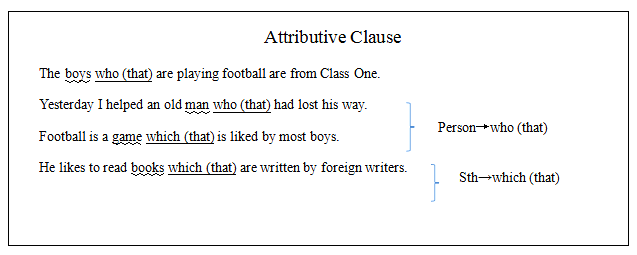
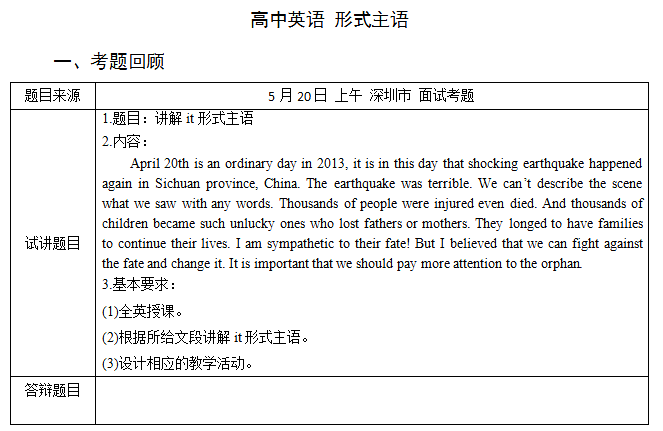
二、考题解析
【教案】
Teaching aims:
Knowledge aim: Students can master the usage of formal subject.
Ability aim: Students can use formal subject to communicate in their daily life.
Emotional aim: Students can enhance their interest in learning English.
Key and difficult point: Students can use formal subject to communicate in their daily life.
Teaching procedure:
Step 1: Warming-up
The teacher plays a documentary video about the earthquake in Wenchuan. Then asks students to talk about their feelings after watching. And lead in the topic.
Step 2: Presentation
The teacher lets students to read the passage and get the main idea. Then the teacher picks the last sentence out. The teacher will use the sentence as example to explain the structure and usage of formal subject.
Step 3: Practice
After explaining, the teacher will show some normal sentences. Students should transfer them into formal subject structure.
For example: Taking good care of the orphans is very important.
→It is very important to take good care of the orphans.
Step4: Production
The teacher lets students talk with their deskmates. They should come up with some ways to help the orphans. Then invites some students to show their opinions.
Step5: Summary and Homework
The teacher summarizes what they have learnt today. Then after class, students could say something to these orphans and take a video. The teacher will help them sent it to the orphan.
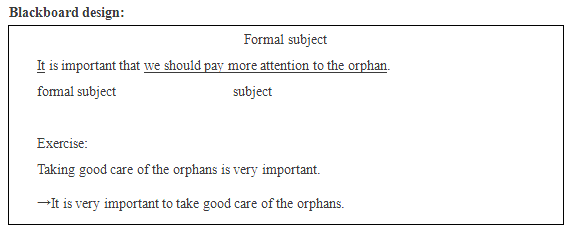
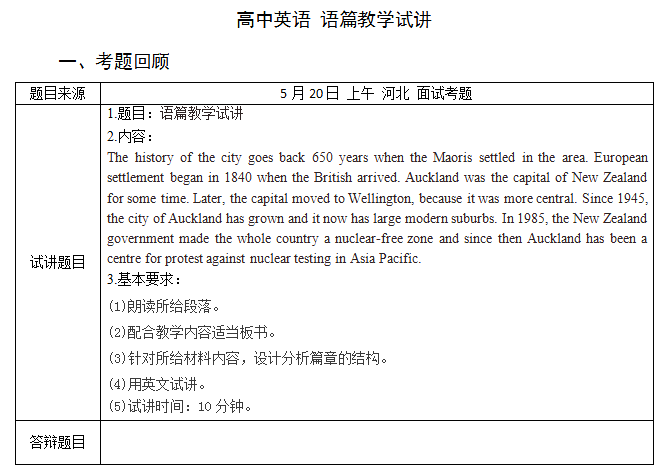
二、考题解析
【教案】
Teaching aims:
Knowledge aim: students will know more about the history of New Zealand.
Ability aim: students can catch some detailed information about the passage.
Emotional aim: students will appreciate different culture and history.
Key and difficult point:
Students will get the history about New Zealand.
Students can express their ideas about the topic.
Teaching procedure:
Step 1: Warming-up
Greet the students.
Watch a clip about “Dad, where are we going” and try to describe the video.
Step 2: Pre-reading
Show some pictures to introduce New Zealand’s background information.
Step 3: While-reading
1st reading: leave the question to you--try to find the key time-points?
2nd reading: now try to find the issues according to responding time-points?
3rd reading: leave the question to them-what is the capital before and now?
Step4: Post-reading
Activity 1: invite two students to retell the passage according the timeline on the blackboard.
Activity 2: divide them into groups of 3 to talk about which country do they like best?
Step5: Summary and homework
Invite a student to make a summary then leave them the homework-search online for the development of coffee culture in China.
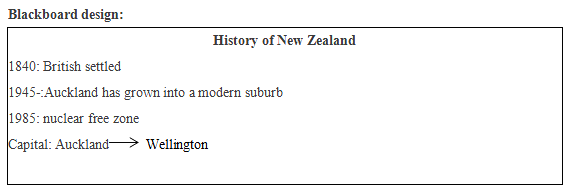
- 2018年上半年高中英语教师资格面试试题(精选)...
2018-11-18
- 2018年上半年高中英语教师资格面试试题(精选)...
2018-11-18
- 2018年上半年高中英语教师资格面试试题(精选)...
2018-11-18
- 2018年上半年小学语文教师资格面试试题(精选)...
2018-11-15
- 2018年上半年小学语文教师资格面试试题(精选)...
2018-11-15


